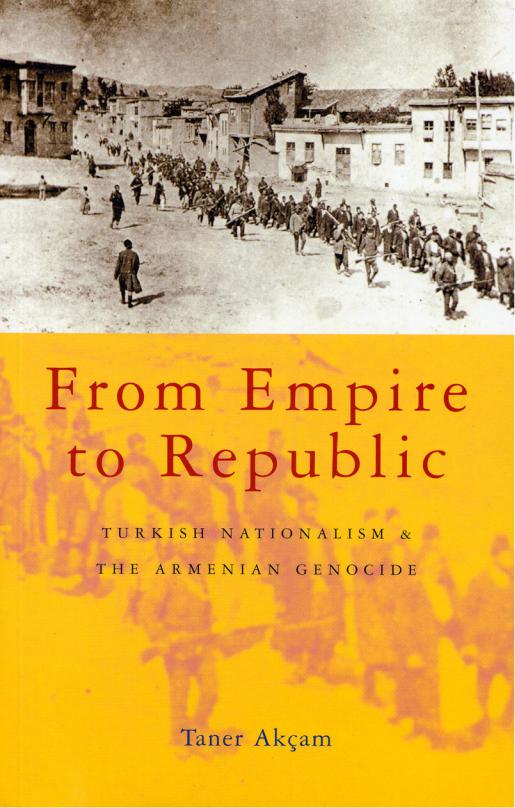
Taner_Akcam_From_Empire_to_Republic_Turkish_N
.pdf
About the Author
Taner Akçam was born in the province of Kars-Ardahan in the northeast of Turkey and became interested in Turkish politics at an early age. He was very active in the student movement of the generation of 1968 and, as the editor-in-chief of a political journal, was arrested in 1976 and sentenced to ten years’ imprisonment. He managed to escape one year later and fled to Germany.
He received his Ph.D. from Hanover University with a dissertation titled, Turkish Nationalism and the Armenian Genocide: On the Background of the Military Tribunals in Istanbul Between 1919 and 1922. He has since lectured and published extensively on this topic, with ten books and half a dozen articles in Turkish and German.
From 1988 to 2000, he held the position of Research Scientist in Sociology at the Hamburg Institute for Social Research. His scholarly interests focused on violence and torture in Turkey, a subject on which he has published a number of books and articles. He has also written extensively on Turkish national identity.
He has twice been Visiting Scholar at the Armenian Research Center, University of Michigan–Dearborn. He was Visiting Professor of Sociology at the University of Michigan–Ann Arbor, 2000–2001 and since then has been Visiting Professor of History at the University of Minnesota–Twin Cities.

From Empire
to Republic
Turkish Nationalism
and the Armenian Genocide
Taner Akçam
Zed Books
LONDON & NEW YORK
From Empire to Republic: Turkish Nationalism and the Armenian Genocide was first published in 2004 by
Zed Books Ltd, 7 Cynthia Street, London N1 9JF, UK and Room 400, 175 Fifth Avenue, New York, NY 10010, USA www.zedbooks.co.uk
Copyright © Zoryan Institute, 2004
The right of Taner Akçam to be identified as the author of this work has been asserted by him in accordance with the Copyright, Designs and Patents Act, 1988
Cover design by Andrew Corbett Designed and set in 10/12 pt Times New Roman
by Long House, Cumbria, UK
Printed and bound in Malta by Gutenberg Press
Distributed in the USA exclusively by Palgrave Macmillan, a division of St Martin’s Press, LLC, 175 Fifth Avenue, New York, NY 10010
All rights reserved
A catalogue record for this book is available from the British Library
US Cataloging-in-Publication Data is available from the Library of Congress
ISBN Hb 1 84277 526 X
Pb 1 84277 527 8
Contents
Preface |
ix |
|
Introduction |
1 |
|
1 |
What Are Turkey’s Fundamental Problems? |
|
|
A Model for Understanding Turkey Today |
11 |
2 |
A Theoretical Approach to Understanding |
|
|
Turkish National Identity |
39 |
3 |
Some Aspects of Turkish National Identity |
|
|
and the Armenian Genocide |
59 |
4 |
The Homogenizing and Ethnic Cleansing of Anatolia |
115 |
5 |
The Decision for Genocide in Light of Ottoman-Turkish |
|
|
Documents |
158 |
6 |
The Treaties of Sèvres and Lausanne: |
|
|
An Alternative Perspective |
180 |
7 |
The Causes and Effects of Making Turkish History Taboo |
208 |
8 |
The Genocide and Turkey |
226 |
9 |
Some Theoretical Thoughts on the Obstacles to |
|
|
Armenian–Turkish Reconciliation |
243 |
Select Bibliography |
254 |
|
Index |
|
265 |
To Jan Philipp Reemstma
Preface
I remember when, during the early 1980s, I was offered the opportunity to meet with the ASALA,1 I became extremely angry. I recall even yelling at the hapless individual who had made the proposal: ‘Don’t you ever bring up this subject again, nor do I want to hear the name of that organization from your lips. It’s an issue that’s being put out there by some dark forces and I have nothing to say to this organization, which is an extension of these dark forces.’ (The term ‘dark forces’ was commonly used to refer to foreign secret services and foreign powers.)
It was actually the typical reflexive response of a Turkish intellectual’s struggle to deal with the issue, which was regarded as very complicated and troublesome. One preferred to keep oneself aloof from the issue, especially in light of ‘the cooperation of Armenians with the imperialist powers.’ I can see clearly today that the real problem lay neither with the type of organization ASALA was nor with the question of whether Armenians had ‘made common cause with imperialist powers.’ The real problem was that the subject referred to as the ‘Armenian Problem’ occupied such a perverse place in our mind. The subject was so foreign to our way of thinking and the way we viewed the world (our Weltanschauung) that to approach it seriously meant risking all of the concepts or models we had used to explain our world and ourselves. Our entrenched belief systems constituted an obstacle to understanding the subject. I refer to this as a ‘fear of confronting’ the issue.
It is fair to say that political parties and even individuals with diametrically opposed ideas nevertheless maintain a common mindset. They perceive the world and themselves with the same worldview. We can exemplify this mindset, which has such a fear of examining the Armenian Genocide, thus: ‘The Ottoman Empire was the target of divisive maneuvers by the Western imperialists. Turks established their independent state by defending the last bit of territory they held in their power. The Armenians
ix
